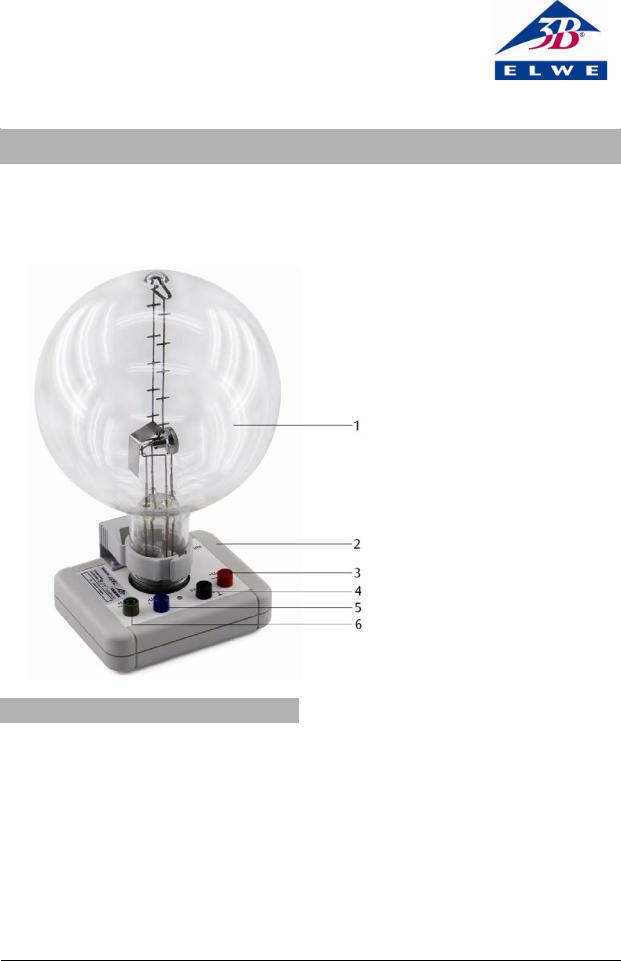3B Scientific Fine Beam Tube on Connector Base User Manual

3B SCIENTIFIC® PHYSICS
Fine Beam Tube on Connection Base 1000904
Instruction sheet
09/12 ALF
1. Safety instructions
Hot cathode tubes are thin-walled, highly evacuated glass tubes. Treat them carefully as there is a risk of implosion.
•Do not subject the tube to mechanical stresses.
If voltage or current is too high or the cathode is at the wrong temperature, it can lead to the tube becoming destroyed.
•Do not exceed the stated operating parameters.
When the tube is in operation, the terminals of the tube may be at high voltages with which it is dangerous to come into contact.
1Fine beam tube
2Connector base
3Connection for anode
4Connection for cathode
5Connection for Wehnelt cylinder
6Connection for heater
•Only use safety experiment leads for connecting circuits.
•Only change circuits with power supply switched off.
•Set up or dismantle the tubes only when the power supply unit is switched off.
When the tube is in operation, the stock of the tube may get hot.
•Allow the tube to cool before putting away the apparatus.
The compliance with the EC directive on electromagnetic compatibility is only guaranteed when using the recommended power supplies.
1

2. Description
The Fine Beam Tube is used for investigating the deflection of cathode rays in a uniform magnetic field produced by a pair of Helmholtz coils (1000906). In addition, it can also be used for quantitative determination of the specific charge of an electron e/m.
Located inside a glass bulb with a neon residual gas atmosphere is an electron gun, which consists of an indirectly heated oxide cathode, a Wehnelt cylinder and a perforated anode. The gas atoms are ionised along the path of the electrons and a narrow, welldefined, luminescent beam is produced. Incorporated measurement marks facilitate a parallax-free determination of the diameter of the circular path of the beam deflected in the magnetic field.
The Fine Beam Tube is mounted on a base with coloured connectors. In order to protect the tube, a protective circuit is built into the base, which shuts off any voltage in excess of the base’s preset cut-off voltage. The protective circuit prevents excessive voltages from damaging the heater filament and ensures a “smooth” switch-on response once the voltage is applied.
3. Technical data
Gas filling: |
Neon |
Gas pressure: |
1,3 x 10-5 bar |
Filament voltage: |
5 to 7 V DC (see cut-off- |
|
voltage on tube socket) |
Filament current: |
< 150 mA |
Wehnelt voltage: |
0 bis -50 V |
Anode voltage: |
200 to 300 V |
Anode current: |
< 0.3 mA |
Diameter of fine beam path: 20 to 120 mm |
|
Division spacing: |
20 mm |
Tube diameter: |
160 mm |
Total height incl. base: |
260 mm |
Base plate: |
115 x 115 x 35 mm3 |
Weight: |
approx. 820 g |
4. Basic principles
An electron moving with velocity v in a direction perpendicular to a uniform magnetic field B experiences a Lorentz force in a direction perpendicular to both the velocity and the magnetic field
F = e v B |
(1) |
e: elementary charge |
|
This gives rise to a centripetal force on the electron in a circular path with radius r, where
F = |
m v2 |
and |
(2) |
|
r |
||||
|
|
|
m is the mass of an electron. Thus,
e B = |
m v |
(3) |
|
r |
|||
|
|
The velocity v depends on the accelerating voltage of the electron gun:
v = 2 |
e |
U |
(4) |
|
m |
|
|
Therefore, the specific charge of an electron is given by:
e |
= |
2 U |
(5) |
m |
(r B)2 |
If we measure the radius of the circular orbit in each case for different accelerating voltages U and different magnetic fields B, then, according to equation 5, the measured values can be plotted in a graph of r2B2 against 2U as a straight line through the origin with slope e/m.
The magnetic field B generated in a pair of Helmholtz coils is proportional to the current IH passing through a single coil. The constant of proportionality k can be determined from the coil radius R = 147.5 mm and the number of turns N = 124 per coil:
B = k IH where
|
4 |
3 |
|
−7 Vs |
|
N |
|
mT |
||
2 |
4π 10 |
|
= 0,756 |
|||||||
k = |
|
|
|
|
|
|
|
|
||
5 |
|
|
Am |
R |
A |
|||||
|
|
|
|
|
|
|
||||
Thus, all parameters for the specific charge are known.
2
